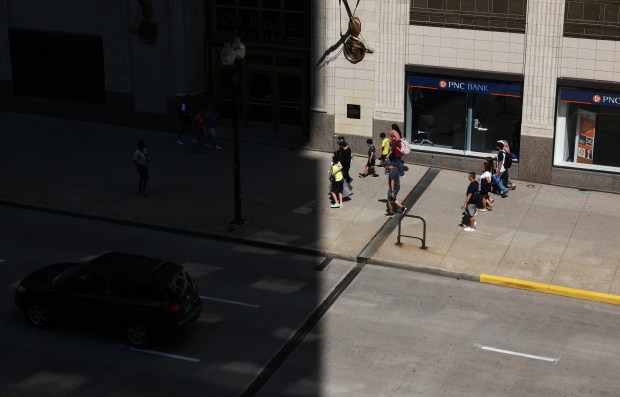As the sun beat down on the Humboldt Park apartment building Thursday, Juanita Taylor and her five young children found no relief indoors. Her oldest boy, 12, played a video game while the younger children slept and watched TV. With no air conditioning, the public housing apartment felt hot and stuffy.
Ahead of a heat wave expected to hit Chicago this weekend, Taylor was the grateful beneficiary of a community effort to loan and install AC units for renters across three West Side neighborhoods. Dangerous heat, including triple-digit stretches in some cities, has embroiled western states for the past week and is headed east.
Two members of a tenants organization quickly set up a window air conditioning unit in Taylor’s bedroom, right above her youngest child’s car-shaped bed. “Oh, I feel good already!” she said shortly after the unit powered up.
The 33-year-old mother, whose children range in age from 1 to 12, said her asthma has worsened in recent hot weather. She found out about the program, dubbed the People’s Cooling Army, from a neighbor.
Access to air conditioning, especially in large cities, is becoming a critical part of combating extreme heat made more intense and more frequent in the summer months by climate change from human activities.
Rising temperatures are causing electricity bills to surge nationwide, and they pose a particular problem for urban areas. A study released Wednesday by the climate science nonprofit Climate Central found that the abundance of skyscrapers and asphalt and lack of green space in Chicago and five other major U.S. cities traps high temperatures, amplifying the effects of heat by more than 8 degrees for at least 1 million people in each of those cities.
This phenomenon, known as the urban heat island effect, exacerbates disparities across income lines. In Illinois, cooling costs during the summer months have risen 10% from last year, higher than the national average of 8%.
“Chicago is a very good example where you’ve got areas of the city where the capacity for that environment to increase heat is far higher than average,” said Peter Girard, vice president of communications for Climate Central. “And as the climate warms, and as we have heat events like what we’re seeing across so much of the country now, those places are where people are most at risk.”
More people are killed and hospitalized during heat waves than any other extreme weather event, experts say.
Climate Central found Chicago’s average urban heat island index is 8.71 degrees, meaning the city has the potential to be that much hotter on a given day, particularly when temperatures are already high. For instance, on a 97-degree day such as June 17 in Chicago, the locally measured average temperature might have been closer to 88 or 89 degrees without the added heat from the urban environment.
In certain areas of the Loop and Streeterville, the urban heat island index could average, respectively, up to 12.4 and 12.7 degrees hotter on a given day, according to Climate Central. In neighborhoods in and near industrial corridors on the South and West sides, including Humboldt Park, Little Village and Brighton Park, indexes in several block groups hover above 10 degrees but can also be as high as 12 degrees.
Climate Central is an organization of scientists and communicators who research and share the science of and possible solutions to climate change, focusing on how it affects people’s lives. They analyzed the distribution of land cover types such as trees and paved areas, as well as building height and population density, in census blocks across 65 large cities to understand where sunlight is absorbed most easily, boosting temperatures. The study shows residents of Chicago, New York City, Los Angeles, Houston, San Antonio and Dallas face the highest rates of exposure to urban heat.
A lack of trees or parks, and housing policies such as discriminatory redlining practices and what advocates say are inadequate landlord cooling requirements can expose people of color, low-income families who can’t afford rising electricity bills and renters with no AC access to higher urban heat island effects.
“As income goes up, you are likely to have central AC … about 19% of low-income families don’t have cooling at all,” said Mark Wolfe, executive director of the National Energy Assistance Directors Association, which helps states manage energy assistance programs. “The message is that as temperatures rise you need more electricity to cool your house. You can take other measures, of course, but the point (is) that there’s a cost to climate change.”
Higher temps, cooling demand
On a recent afternoon, a slow but steady trickle of Chicagoans walked up the steps to the Garfield Community Service Center where they could find respite from the searing summer weather. At one point, a woman traipsed in, two milkshakes in hand.
A man walked up to a table set up in front of the center at 10 S. Kedzie Ave. and asked for two water bottles. Others stopped to listen to organizers with the All-Chicago Tenant Alliance, the tenants’ rights group behind the AC program, who said interest in their efforts to lend donated air conditioning units to tenants at no cost exploded during the third week of June when a heat wave swept through the country and hit Chicago with a streak of 90-degree days.
Organizers said the program has since received over 2,000 requests from all over the city, including some suburbs and even one from as far north as Milwaukee. The overwhelming number of requests forced the small nine-person group to limit their service area to Humboldt Park, Garfield Park and Hermosa, three neighborhoods with predominantly Black and Hispanic populations, where they have installed more than 50 units out of 70, with more on the way.
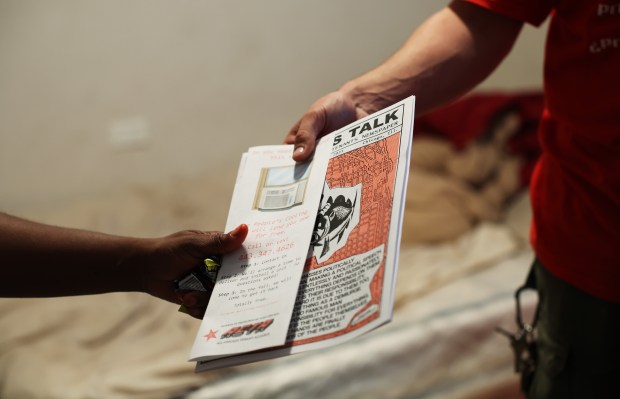
“When we started this year, we wanted the PCA to be a citywide program,” said Sam Diamonte, one of the tenant alliance organizers. “We knew the audience for the program was the tenants across the city who have been left to be in hot apartments, tenants across the city who have been asked to live in apartments where they could not sleep, where they were always covered in sweat, where their children were unsafe.”
Most tenants requesting help would have to pay costly installation fees to their landlords to receive AC units.
According to the Chicago Housing Authority in a statement Friday, central air and heat are being added to all public housing buildings that are being renovated. Additionally, all CHA senior buildings are required to provide air conditioning, households with a resident who has a medical condition can request an AC unit, and the agency conducts well-being checks on older residents during extreme weather.
“CHA takes the safety of our residents very seriously and we comply with all federal and local regulations around temperature control,” the emailed statement read.
After being contacted, a spokesperson said the CHA planned to have property managers deliver portable AC units to the public housing apartments on Taylor’s Humboldt Park block Friday.
Chicago was much hotter and drier than usual in June; the month’s average temperature of almost 74 degrees was 3.3 degrees above normal. Climate change also contributed to unusually high temperatures on six nights last month, according to Climate Central. When nights don’t cool down much compared to high daytime temperatures, it becomes harder for people to cool off, prolonging heat risk.
“Especially for people who don’t have access to air conditioning, I think anybody who has experienced it intuitively knows you don’t sleep as well, you don’t rest as well,” Girard said. “Your body’s capacity to, essentially, recover from being exposed to high heat during the day is diminished when you can’t find relief at night. And overnight, temperatures in many locations have steadily risen over the last 50 years. It’s, in fact, typically a sharper rise than high temperatures.”
These warming trends will continue into July, which according to meteorologists is typically the hottest month of the year across the contiguous United States, and since 1970 has become warmer by an average of 1 degree in Chicago. An average increase of a degree or two might seem negligible, but it obscures the disproportionate effects of climate change in certain areas where temperatures have climbed and remain higher than that average.
Above-average warming is being felt far and wide around the world and driving up cooling demand all over the United States. For 13 consecutive months, every month has broken temperature records globally with an average of 2.7 degrees Fahrenheit above pre-industrial levels, or the concentration of heat-trapping greenhouse gases in the atmosphere due to industrialization, according to the Copernicus Climate Change Service in Europe.
In a summer outlook report using federal temperature and electric usage data, the National Energy Assistance Directors Association and the Center for Energy Poverty and Climate projected that keeping cool indoors between June and September will increase the average American household’s bills by almost 8% to an average of $719, up from $661 last year — and up from $476 a decade ago. In parts of the Midwest, including Illinois, this average would be closer to $581, up almost 10% from $524 last summer.
“The thing is that, if it’s 7% or 5% or 11%, it’s still an increase,” Wolfe said. “What I think public service commissioners are grappling with right now is that high temperatures are becoming the norm rather than the exception, and it’s happening very quickly and getting worse.”
The energy association report notes that these predictions might even understate cooling demand if temperatures continue to increase. Regardless, the inevitable increase would especially burden low-income families that cannot afford to pay their energy bills. Extreme summer heat could force them into a precarious decision: keep their homes at unsafe temperatures, stay cool and incur high utility debt, or forgo other basic needs, including medicine and food to pay electricity bills.
“Low-income families are reluctant to turn on their air conditioning because of the cost,” Wolfe said. “Upper-income people don’t have that same problem; they expect to use air conditioning. That’s the economic divide.”
In the most recent monthly report from the Illinois Commerce Commission, over 765,000 Illinois residents were behind on their electricity bills in May, collectively owing more than $255 million to Ameren and ComEd, the largest electricity providers in the state.
Even if they borrow AC units from the People’s Cooling Army, low-income tenants in Chicago will face the challenge of financing the equipment’s energy demands.
“Our program doesn’t stop with installing an AC,” said Luz Rojas-Ortiz, another tenant alliance member. “This is a way to meet tenants. This is a way to help tenants — a temporary way. But the issues do not stop there.”
Unequal and invisible burden
While the devastation of hurricanes, tornadoes, floods and the bitter winter cold might deliver more visually impactful images of the consequences of climate change on humans and the environment, heat is the deadliest weather phenomenon, killing more people every year than any other hazard, according to the National Weather Service.
More than 60 million Americans were under heat alerts from the National Weather Service on Thursday, as a searing heat wave engulfed the West for more than a week before shifting east. Temperatures are forecast to hit the mid-90s on Sunday and Monday in Chicago. The city’s Office for Emergency Management and Communications released a weather advisory for high temperatures and humid conditions that can lead to extreme heat on both days, which the National Weather Service says poses a major heat risk without effective cooling or adequate hydration.
Officials believe heat may be to blame for more than 90 deaths reported in the West this month, though it could take months of investigations for the authorities to determine an accurate death toll, according to the New York Times.
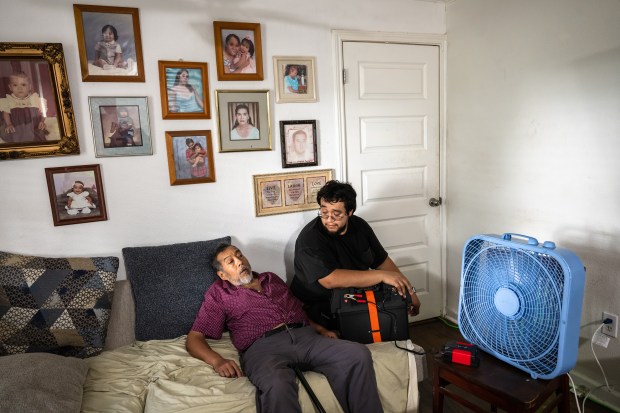
More than a dozen high-temperature records were expected to fall, from the West Coast to the High Plains, where temperatures soared from the upper 90s into the triple digits. On Friday, Las Vegas broke a record with its sixth consecutive day of temperatures reaching or exceeding 115 degrees, the Weather Service said.
Some populations are more vulnerable to heat, such as elderly people, babies, infants, outdoor workers and anyone living alone. This also includes those with chronic health conditions, including cardiovascular disease, respiratory issues and diabetes — all of which, according to medical research, disproportionately affect Black and Hispanic people, Native Americans and other minorities, and for which low-income people are less likely to have received recurring medical treatment or preventive care.
Dangerously high temperatures are becoming inescapable around the country, and the death rate directly tied to heat exposure is rising as well as heat-related premature deaths, according to a National Library of Medicine report.
Across the 65 cities that Climate Central analyzed, the total population living in census block groups with an urban heat index of over 8 degrees was nearly 34 million — that’s 68% of the 50 million people living in the surveyed cities. This percentage is reflected in Chicago, where 1.7 million of almost 2.7 million people experience that 8-degree index or higher. Just over 37,000 people in Chicago experience the highest index of at least 12 degrees.
“It’s a relatively small number of people who are exposed to these maximum, at least in our scale, urban heat island index values,” Girard said. “But it’s not insignificant that you’ve got 37,000 people living in Chicago who are exposed to, at least, a 12-degree potential temperature increase on top temperatures. At times like these, in which you’re seeing extreme summer heat, those people are most at risk from heat-related illness.”
Because land usage and population density vary between neighborhoods and census tracts, this index can be higher where there is heightened human activity, and asphalt surfaces absorb sunlight and radiate heat. It’s why it can get so hot in Chicago’s main business district and tourist destinations downtown — where transportation and building operations accommodate thousands of people daily, where hard surfaces such as roads, buildings and parking lots abound, and where many more people in addition to those who live there can be exposed to these high temperatures.

On the other hand, where plants and green spaces are plentiful and help cool temperatures, the urban heat island index can be minimal. Yet even trees have been deployed inconsistently across demographics; a 2022 Tribune investigation found the city planted more trees in wealthier, whiter neighborhoods.
A Tribune analysis last year also found that cooler areas with more white residents had far more parks and bus shelters, which provide relief from the heat, than areas with the hottest average surface temperatures and more members of minority groups. Additionally, experts say racially discriminatory housing policies nationwide such as redlining have historically pushed large minority populations into industrial zones, where previous research and government studies have shown urban temperatures are higher than in other areas.
Not a luxury
Climate change has made access to cool shelter more than a simple matter of comfort and as basic as the need for warm shelter during colder months. This is why advocates and experts say business as usual — such as only activating cooling centers during heat waves and current building cooling requirements — is no longer a sufficient public health approach.
“I think the problem is that the strategies we’re coming up with are dated. So, a cooling center works if it’s just one day,” Wolfe said. “It doesn’t work if it’s hot for a week or two weeks. You can’t ask your entire low-income population, your entire homeless population (to) all go to the library — that doesn’t work.
“That’s when people die,” he added. “Some believe that cooling is a luxury. No one believes having access to heat is a luxury.”
Searchable maps: Explore heat disparities and cooling resources in your neighborhood
Kyra Woods, a project manager with the city’s Department of Environment, said other city-owned and public sites are available for cooling off in the summer, even if they might not be as equipped to connect residents with resources as the six community service centers operated by the Department of Family and Support Services.
“But consider the broad network of libraries, parks, the community service centers, the senior satellites, even our city colleges,” Woods said. “You get to nearly 300 sites across the city.”
But gaps remain. One day during last month’s heat wave, all public library locations and five of the six cooling centers were closed to the public in observance of the Juneteenth holiday, though Park District pools and field houses remained open. Woods added that the city continues evaluating whether there’s a need to activate more cooling centers or expand hours of operation.
During a week of similarly record-breaking high temperatures in May 2022, three women died inside their sweltering apartments in a Rogers Park senior housing facility. Delores McNeely, 76, Gwendolyn Osborne, 72, and Janice Reed, 68, were found unresponsive in their units at the James Sneider Apartments — their autopsies revealed they had died of environmental heat exposure in conditions family members would describe as “oven-like” after residents had repeatedly asked property managers to turn off the heat and turn on the air conditioning.
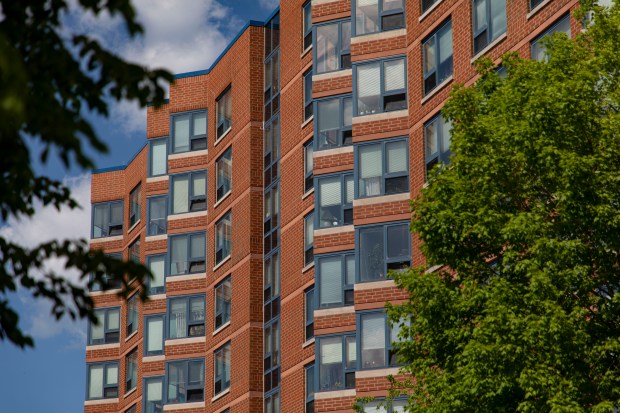
The deaths spurred the Illinois Senate to pass a measure the following year requiring all state-funded affordable housing to have air conditioning installed and controlled by residents. That same year, a new state law was passed prohibiting utility residential shutoff due to nonpayment when temperatures are forecast to reach over 90 degrees, or when the National Weather Service issues a heat advisory or warning.
In 2022, the Chicago City Council passed a cooling ordinance that requires new or existing buildings over 80 feet tall, with more than 100 residential units or that operate as elderly housing to install AC equipment in indoor common areas and make these available to residents as cooling centers when the outdoor heat index — a combination of atmospheric temperature and relative humidity, and a good indication of how humans experience heat — exceeds 80 degrees.
“There’s just not that many buildings like that in most neighborhoods,” said Rojas-Ortiz, one of the volunteers with the People’s Cooling Army. “And if a building doesn’t meet the ordinance criteria, what are the tenants supposed to do? … How can an entire building of tenants fit inside a laundry room or lobby and where they can sleep, cook?”
Woods said that climate and extreme heat are so nuanced that not any singular policy can solve the swath of issues.
“There are definitely a lot of things to address, and I think that means that there are a lot of opportunities for people to show up, to lead, and for innovation and creativity and collaboration,” she said. “That particular policy does not capture all types of residents.”
She said it’s one of the reasons the city continues to connect Chicagoans, especially those visiting cooling centers, with utility relief programs like CEDA, the Community and Economic Development Association of Cook County, which operates the Low Income Home Energy Assistance Program.
The Illinois Commerce Commission expects to offer new low-income discount rates in October for eligible natural gas customers whose incomes are up to 300% of the federal poverty level. An ICC spokesperson said similar rates are expected to be available for eligible electric customers by 2025, subject to approval.
Besides tightening ordinances to keep up with temperatures and assisting renters and homeowners with the growing costs of cooling, local governments can also increase the tree canopy and plant rooftop gardens, as well as develop cool pavements with reflective or permeable materials to reduce heat amplification.
But as cooling demand increases energy use, the power grid can also become strained and release more greenhouse gas emissions from electricity generation through fossil fuel burning.
For instance, as people crank up their air conditioning units, these can contribute to the outdoor heat they’re trying to escape. A 2020 study from Lawrence Berkeley National Laboratory in California found that during a heat wave, human activities, including running the AC, can add up to 20% to outside temperatures.
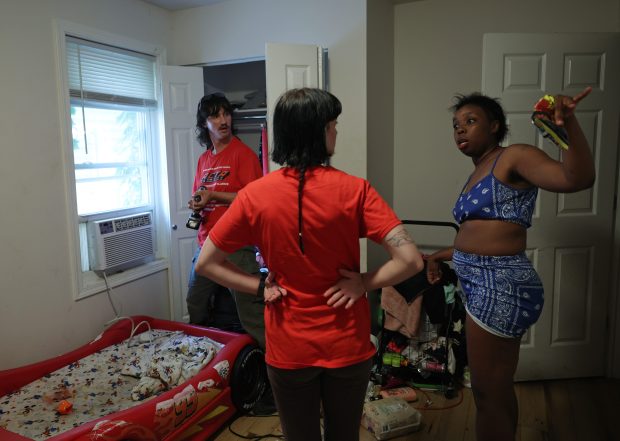
Heat pumps are growing in popularity as an alternative to air conditioning. These extract heat from indoors and expel it outside, or vice versa by extracting heat from outdoors and channeling it inside.
“AC and heat pumps are very similar with respect to the amount of heat they release to (the) outdoors during cooling operations,” Payam Delgoshaei, HVAC and refrigeration technology manager at the Department of Energy’s Buildings Technologies Office, said in an email. “A heat pump does not create heat but rather transfers existing heat either indoors or outdoors, depending on whether you’re warming or cooling the home.”
Since they expel excess heat outside of a building, heat pumps can also worsen the urban heat island effect, Wolfe said, which strengthens the case for reducing reliance on mechanical air conditioning. Alternative ways to cool buildings include installing external shading, increasing natural ventilation and building roofs with thermal insulation, or that reflect sunlight and repel heat.
But because heat pumps can serve both summer and winter functions in places such as the Midwest, they can also reduce reliance on natural gas, a fossil fuel, for heating. In the winter, heat pumps powered by clean energy can offer lower energy costs compared to other heating systems and, and can also release fewer greenhouse gases.
“The goal is to increase access to cooling without increasing emissions that make climate change worse, so that’s why we need a comprehensive solution for heating and cooling buildings,” Wolfe said, “so that you don’t find that, as a result of everyone in Chicago now having access to cooling, we’re producing more emissions over the course of the year.”
Delgoshaei said yearly energy costs for a heat pump depend on the equipment and its correct installation, though its energy efficiency is similar to that of traditional air conditioners. Tax credits through the Inflation Reduction Act are available to help consumers afford this alternative to AC.
“You can swap out technology and appliances for greater efficiency, but we should also continue to aim for a cleaner grid,” Woods said. “They do go hand in hand. … I do think that the electric grid transition, particularly if centered on principles of equity, inclusion and affordability, would actually allow us to introduce affordable cooling for those residents who have not had it.”


